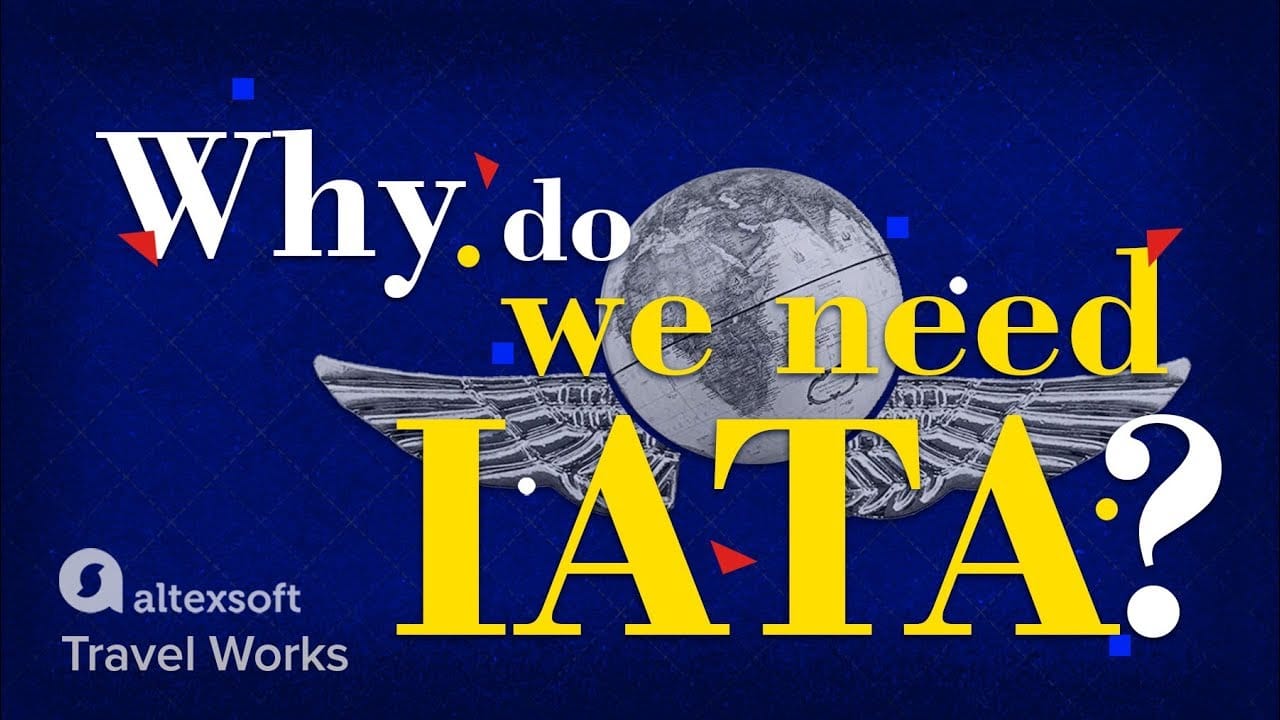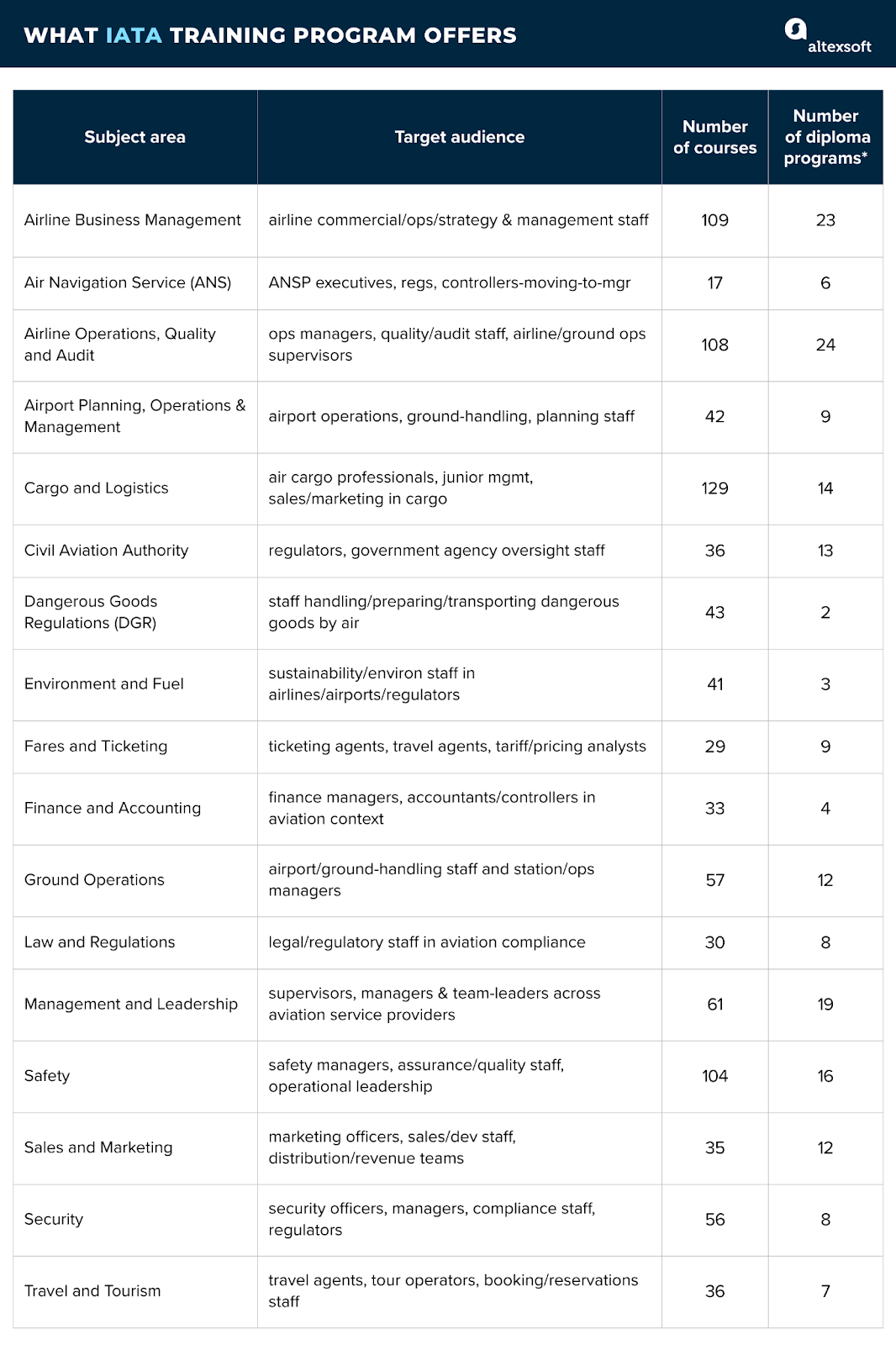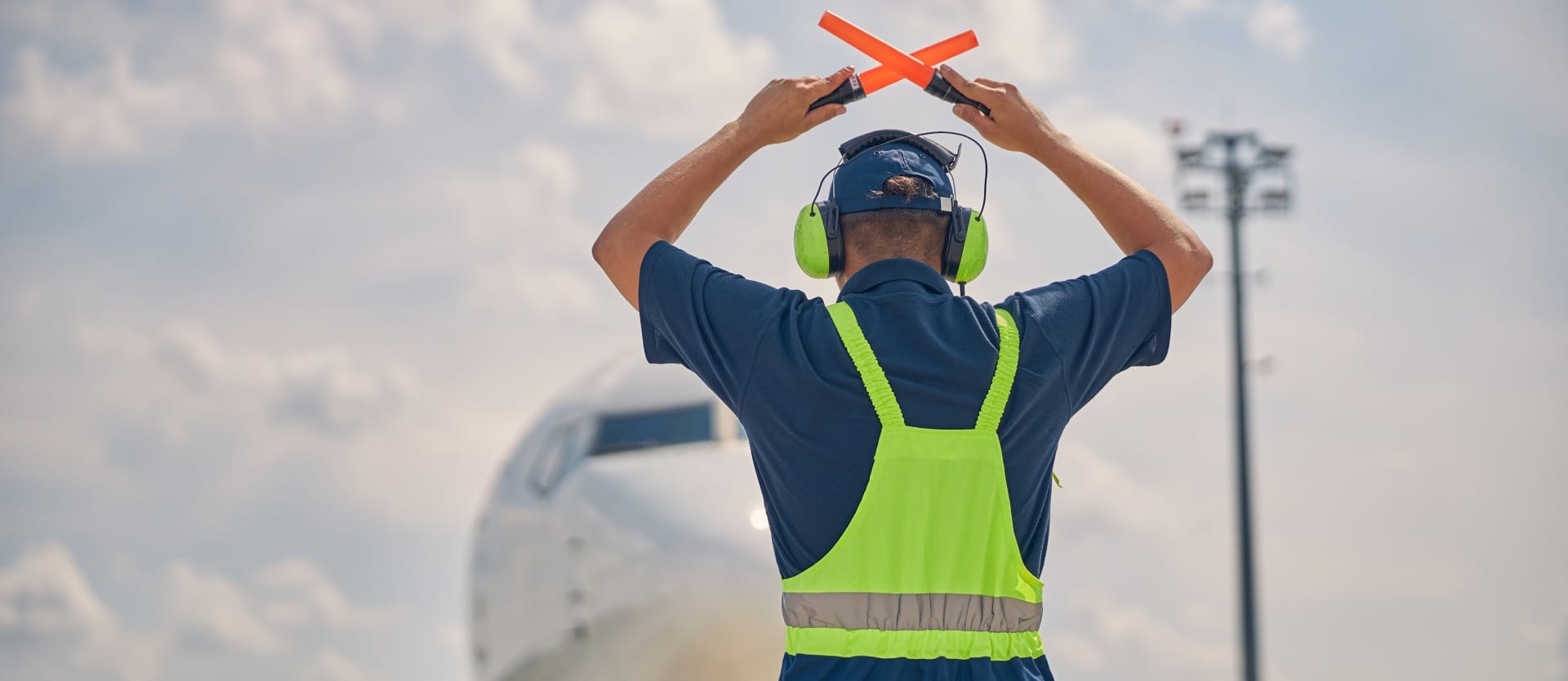The International Air Transport Association (IATA) represents nearly 350 airlines worldwide, accounting for more than 80 percent of global air traffic. Beyond its regulatory and advocacy work, IATA plays another crucial role — it sets global standards for training and professional development throughout the entire aviation value chain.
The IATA Training program helps individuals and organizations build the expertise needed to keep aviation safe, sustainable, and efficient.
In this article, we will explain how the IATA Training program works, who it is intended for, and what distinguishes a diploma from a certificate. We will look at the existing topics and courses—hundreds of them—and show you why you should take these courses in the first place.
What is IATA Training
IATA provides one of the world’s most comprehensive professional training programs for the aviation and travel industries. Its main goal is to ensure that people working across airlines, airports, civil aviation authorities, and related businesses have the technical knowledge, regulatory awareness, and management skills required to meet international operational and safety standards.


What is IATA
IATA’s portfolio includes over 600 courses and diploma programs covering the entire aviation ecosystem — from airline business management and safety to travel and tourism, cargo, finance, and sustainability. Courses are developed in alignment with standards set by IATA and the International Civil Aviation Organization (ICAO) and are regularly updated to reflect evolving regulations, technologies, and industry practices.
Professionals take IATA training for three main reasons:
- to enter the aviation industry with recognized qualifications,
- to advance within their careers by gaining specialized or managerial skills, or
- to meet compliance or role-specific requirements
For newcomers, IATA Training provides a structured entry into a globally regulated industry. For experienced staff, it helps formalize existing knowledge, satisfy standards, or prepare for leadership positions.
What IATA offers: subject areas and portfolio

What IATA offers: subject areas & portfolio
As of October 2025, IATA Training consists of 675 courses and diploma programs. The classes cover nearly every player in the aviation ecosystem (airports, air navigation service providers, travel agencies, freight forwarders, regulators, etc.) and fall into 17 major subject areas, each focusing on a specific aviation operational or business domain.
Airline Business Management covers airline strategy, network planning, and leadership. More details here.
Target audience: airline professionals (commercial, operations, strategy) working toward managerial roles, aviation management staff wanting broader airline-industry business knowledge.
Number of courses and diplomas: 132
Air Navigation Service (ANS) focuses on air traffic management, airspace safety, and communication technologies for air navigation service providers (ANSPs). These courses address both the technical/operational and business/ management sides (e.g., cost reduction strategies, benchmarking, strategic planning, etc.). More details here.
Target audience: executives & senior managers in ANSPs; operational staff (e.g., controllers/supervisors) moving into management; board members of ANSPs
Number of courses and diplomas: 23
Airline Operations, Quality, and Audit emphasizes operational excellence, quality assurance, and internal audit processes. More details here.
Target audience: operations managers, quality managers, audit staff, airline and ground-handling supervisors, and related professionals.
Number of courses and diplomas: 132
Airport Planning, Operations, and Management covers airport planning, terminal operations, ground handling, safety, security, service quality, and collaborative decision-making processes. More details here.
Target audience: airport operations managers, ground handling supervisors, safety and security personnel, and those involved in airport planning and development.
Number of courses and diplomas: 51
Cargo and Logistics includes air cargo management and marketing, revenue optimization, and specialized handling of dangerous goods, pharmaceuticals, and perishables. More details here.
Target audience: professionals of all levels in the air cargo field, junior management in airlines and freight forwarding, and sales and marketing staff in cargo agencies.
Number of courses and diplomas: 143
Civil Aviation Authority embraces aviation safety, security, airspace policy, economic regulation, efficiency, sustainability, consumer protection, and respect for the environment. More details here.
Target audience: regulators and government agencies involved in national aviation system policy, certification, and oversight.
Number of courses and diplomas: 49
Dangerous Goods Regulations (DGR) cover the safe transport of hazardous materials by air in accordance with global standards. The courses are organized as competency-based training and assessment (CBTA), which means they focus on an individual's ability to perform specific tasks and meet required standards. More details here.
Target audience: a wide range of aviation personnel who handle, prepare, accept, transport, or oversee the transportation of dangerous goods by air.
Number of courses and diplomas: 45
Environment and Fuel is about sustainable aviation practices, including carbon offsetting, fuel efficiency, and environmental compliance. It helps aviation professionals responsibly address challenges such as noise, emissions, and waste management. More details here.
Target audience: airline environmental/sustainability managers, airport environmental staff, regulators or government bodies overseeing aviation environmental compliance, ground handling providers needing to align with sustainability standards
Number of courses and diplomas: 44
Fares and Ticketing are practical courses on fare construction and ticketing, using the IATA Billing and Settlement Plan (BSP) and Global Distribution Systems (GDSs). More details here.
Target audience: airline call center/reservations/ticket agents, travel agents, airline tariff and pricing analysts, revenue/accounting staff dealing with ticketing rules.
Number of courses and diplomas: 38
Finance and Accounting build financial management, cost control, and revenue accounting skills for airlines and aviation organizations. More details here.
Target audience: airline finance managers, accountants, controllers, airport finance or revenue management teams, accounting staff in cargo agencies, financial/supervisory staff in travel agencies.
Number of courses and diplomas: 37
Ground Operations train professionals in ramp handling, load control, and airport turnaround coordination. More details here.
Target audience: airport management professionals, marketing, operations, and security, e.g., ground handling staff and supervisors, station/airport operations managers, ramp and passenger services personnel.
Number of courses and diplomas: 69
Law and Regulations explore aviation law, regulatory frameworks, and international conventions governing air transport. More details here.
Target audience: regulators, legal staff, and professionals managing the regulatory process across borders.
Number of courses and diplomas: 39
Management and Leadership cover soft skills and leadership essentials such as communication, teamwork, and performance management. More details here.
Target audience: supervisors, managers, and team leaders across airlines, airports, ground handling, and aviation service providers.
Number of courses and diplomas: 80
Safety is a flagship category addressing safety management systems (SMS), risk mitigation, and accident investigation. More details here.
Target audience: safety managers, safety assurance/quality staff, regulators, audit professionals, and operational leadership roles tasked with maintaining or improving safety performance.
Number of courses and diplomas: 120
Sales and Marketing cover marketing and distribution channels, sales management, advertising, consumer behavior, and communications tailored for the aviation industry. More details here.
Target audience: marketing officers, sales managers, business development staff, revenue and distribution teams, and those working on the product interface, pricing, and customer engagement.
Number of courses and diplomas: 47
Security is dedicated to international security standards and best practices, crisis management, and risk assessment, including threat assessment and compliance with ICAO Annex 17. More details here.
Target audience: from front-line security officers to security managers, compliance staff, and regulators overseeing aviation security.
Number of courses and diplomas: 64
Travel and Tourism include entry-level and advanced programs for travel consultants, agents, and tour operators. Topics span itinerary planning, fares and ticketing, GDSs, destination geography, customer service, travel business management, travel agency accounting, etc. More details here.
Target audience: travel agents, tour operators, agency managers, booking/reservations staff, and newcomers to the travel business.
Number of courses and diplomas: 43
All courses are developed and taught by IATA-certified instructors with deep industry experience.
How IATA training works
Found a course that caught your eye? Excellent. Let’s look at how to move from interest to enrollment — and what you’ll get out of it in the end.
Who can take IATA courses?
Most IATA courses are open to anyone with an interest in aviation, even if they have never worked in the industry before. Entry-level programs — particularly in Travel and Tourism, Ground Operations, or Passenger Services — are designed for beginners and require no prior experience.
Intermediate and advanced courses, such as those in Airline Management, Dangerous Goods Regulations, or Safety Auditing, often require prior industry experience, relevant background knowledge, and strong English skills for professional communication. Certain roles, for example, must meet the ICAO Operational Level 4 English standard, which is the minimum proficiency level that allows pilots and air traffic controllers to operate internationally. Each course page clearly lists its specific entry requirements.
Overall, IATA Training accommodates a wide audience: students preparing for aviation careers, employees of airlines and airports, travel consultants, freight forwarders, regulators, and professionals seeking to align their skills with global aviation standards.
Learning formats
Participants can choose between classroom sessions, live virtual classes, or self-paced e-learning.
Training under an IATA instructor's guidance can be conducted on-site and remotely.
Classroom training is offered at IATA’s own centers in major aviation hubs such as Amsterdam, Geneva, Madrid, Miami, Singapore, and Montreal, as well as at Regional Training Partners (RTPs) and Authorized Training Centers (ATCs).
RTPs act as official extensions of IATA’s training centers in specific regions, while ATCs are licensed institutions — they deliver IATA-approved content but manage their own operations.
Altogether, IATA’s global partner network covers more than 90 countries. You can find the full list of the IATA training partners here.
Not every course is offered everywhere. The availability depends on each partner’s authorization and regional demand. For example, you will find classroom sessions for the Airport Operations Fundamentals in 60 training centers in Africa, the Middle East, and the Asia Pacific, but a specialized course like Airline Marketing for the Leadership and Management Training Program only runs in four ATCs—two in Europe and two in Jakarta.
Virtual classrooms offer the same instructor-led interaction online. To accommodate students in different locations, the live classroom sessions are scheduled across three time zones (UTC-5 for the Americas, UTC+8 for Asia, and UTC+2 for Europe, the Middle East, and Africa).
In-house training for organizations allows either classroom or virtual courses to be hosted on your premises (or another chosen location) for groups of five or more participants. You can select any existing IATA course or ask for a customized program.
Beyond instructor-guided classrooms, there are two self-study options.
E-book courses is studying with the help of an instructor in an ATC, where language adaptations to local markets are available.
E-learning is a totally self-studying option, allowing participants to progress independently.
Duration and certification
Most IATA classroom courses last five days, comprising 40 hours of instruction. Virtual courses are usually shorter — they take three to four days, combining live online sessions with guided self-study.
Exams are conducted in three formats.
Classroom (real or virtual), where you follow the teacher's instructions;
Online with remote supervision, where you are monitored in real time via webcam and screen sharing by a remote proctor to ensure exam integrity;
Online without remote supervision. In this case, IATA doesn’t vouch for your assimilation of the course and therefore doesn’t issue a certificate, but only an Award of Completion, which isn’t an official validation.
An IATA Certificate is awarded after the exam is passed. Participants who achieve 70 percent or higher on exercises/exams receive the IATA Certificate; those attaining 90 percent+ often receive a “special distinction” as well. Airlines, airports, travel agencies, and aviation authorities widely recognize it as proof of specialized training that meets IATA and ICAO standards.
An IATA Diploma is a multi-course program—usually a structured sequence of 3 to 6 courses. Diploma programs may include courses from different subjects. For example, the IATA Airline Management Diploma consists of two required and two elective courses to be completed in three years. The must-have courses focus on the Airline Management subject, while the electives can be chosen from fields like Sales & Marketing, Finance & Accounting, or other relevant subjects.
Also, the same course can be included in different diploma programs.
Pricing and discounts
Pricing varies and depends on location, subject area, delivery format, and the participant’s status. For most five-day classroom courses, the standard rate falls between USD $1,700 and $3,900, with discounted pricing for IATA Members and participants from developing nations, where fees can start as low as $1,180.
IATA also offers early-bird promotions that can reduce costs up to 25 percent for those registering at least six months in advance. Smaller discounts apply for enrollments made three months ahead of the start date. Diploma packages provide further savings for learners taking several related courses.
How to apply for courses
Enrollment is done directly through the IATA Training Portal. Learners create an online profile, select a course, choose their preferred format (classroom, virtual, or e-learning), and complete registration and payment online.
Each course page includes clear details on schedule, fees, delivery method, and prerequisites, along with the option to download a course brochure.
Once registered, students receive access to learning materials and course instructions before the start date.
The impact and benefits of IATA training
Each year, IATA trains over 100,000 aviation professionals from around the world.
For many professionals, these courses open doors to promotions, new specializations, or international career opportunities in the aviation ecosystem. IATA's brand recognition signals to employers worldwide that the holder meets an international operational and regulatory excellence benchmark.
Organizations benefit just as much. According to IATA’s own “Training & Development” overview, 90 percent of companies say their employees applied their new skills in their daily jobs.
Finally, IATA’s global network creates long-term professional value. Alumni join a community of aviation professionals who share best practices, job opportunities, and policy insights. For many, the relationships formed during training are as valuable as the course itself—a gateway into the broader professional world of international aviation.

Olga is a tech journalist at AltexSoft, specializing in travel technologies. With over 25 years of experience in journalism, she began her career writing travel articles for glossy magazines before advancing to editor-in-chief of a specialized media outlet focused on science and travel. Her diverse background also includes roles as a QA specialist and tech writer.
Want to write an article for our blog? Read our requirements and guidelines to become a contributor.

